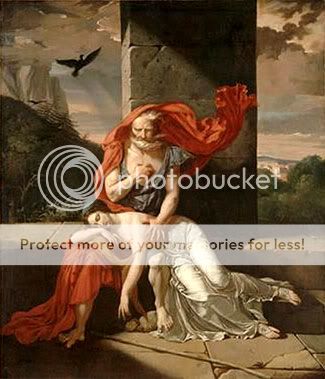If you are using Chrome, click the red hand button at the top right of the screen:

Then select: Don't run on pages on this site
If you do it correctly, the red hand will turn to green and you will no longer see this message.
-=THE TURKEY CURSE=-
by Greg Hill
Revealed by the Apostle Dr. Van Van Mojo as a specific counter to
the evil of the Curse of Greyface, the Turkey Curse is here passed
on to Erisians everywhere for their just protection.
[The Turkey Curse works. It is firmly grounded on the fact that
Greyface and his followers absolutely require an anerisitic
setting to function and that a timely introduction of eristic
vibrations will neutralize their foundation. The Turkey Curse is
designed solely to counteract >negative< anerisitic vibes and if
introduced into a neutral or positive aneristic setting (like a
poet working out word rhythms) it will prove harmless, or at
worst, annoying. It is not designed for use against negative
>eristic< vibes, although it can be used an eristic vehicle to
introduce postive vibes into a misguided eristic setting. In this
instance, it would be responsibility of the Erisian Magician to
manufacture the positive vibrations if results are to be achieved.
CAUTION - all magic is powerful and requires courage and integrity
on the part of the magician. This ritual, if misused, can
backfire. Positive motivation is essential for self-protection.]
TO PERFORM THE TURKEY CURSE--
Take a foot stance as if you were John L. Sullivan preparing for
fisticuffs. Face the particular grey-face you wish to
short-circuit (e.g. a street preacher), or towards the direction
of the negative aneristic vibration that you wish to neutralize
(e.g. the White House). Begin waving your arms in any elaborate
manner and make motions with your hands as though you were
Mandrake feeling up a sexy giantess (Dr. Strange imitations are
fine). Chant, loudly and clearly:
GOBBLE, GOBBLE, GOBBLE, GOBBLE, GOBBLE!!
The results will be instantly apparent.
This text is for Romanian readers but I hope to translated soon.
It`s a parallel about the Romatic and the Classicist Hero as two opposed and ideal poles of aesthetics as the great man of letters George Calinescu saw them.
"Nu există în realitate un fenomen artistic pur, clasic ori romantic. Racine e şi clasic şi romantic. Clasicismul elin e şi clasic, şi romantic. Romantismul modern e şi romantic, e şi clasic, şi nu e vorba de vreun amestec material de teme, influenţe tradiţii căci nu ne punem pe teren istoric, ci de impurităţi structurale.
Clasicism-Romantism sânt două tipuri ideale, inexistente practic în stare genuină, reperabile numai la analiza în retortă.
Individul clasic este utopia unui om perfect sănătos trupeşte şi sufleteşte, “normal” (slujind drept normă altora), deci “canonic “.
Individul romantic este utopia unui om complet “anormal” (înţelege excepţional), dezechilibrat şi bolnav, adică cu sensibilitatea şi intelectul exacerbate la maxim, rezumând toate aspectele spirituale de la brută la geniu. Expresiile trebuiesc luate într-un sens cu totul literar, evitându-se confuzia cu patologia medicală.
Din punct de vedere sanitar, eroul clasic e “sănătos” cu o sănătate însă de tipul gladiator care presupune o insuficienţă a antenelor nervoase.
Romanticul, se ştie, este maladiv, infirm, tuberculos, nebun, orb, lepros (cităm suferinţele “clasice” ale romanticului) atribuindu-i-se utopic o complexitate senzorială şi sufletească mai mare decât aceşti bolnavi o au în realitate.
Trupeşte, eroul clasic e “mai mare”, fără expresie clară, adâncă, de o oarecare asprime lapidară. Clasicismul a cultivat îndeosebi arta statuară, unde se eviă din motive tehnice ridiculul dimensiunilor reale. Eroul clsic este în acelaşi timp un semizeu ori un rege cu ascendenţă divină (Achille) încât iluzia de “mai mare” este canonică, inerentă formulei dignităţii umane, caracteristică clasicismului. [..]
Eroul romantic e cocoşat, orb, şchiop, etc. sau în fine niciodată “normal” frumos, ci de o frumuseţe stranie, de o delicateţă maladivă. [..]
Sub raportul vârstei, clasicul are o unică vârstă incertă, de tânăr perfect dezvoltat ( vârsta lui Achille). Romanticul e foarte tînăr (13-14 ani femeia) sau foarte bătrân.
Trei sânt profesiile clasicului: rege, păstor, vânător sau, mai bine ziss, una singură, de rege care păstoreşte şi vînează (războiul e implicat).
Sânt clare acum motivele de ordin speculativ pentru care istoria confirmă preferinţa în romantism pentru profesiile următoare: proletar, călugăr, student, militar, puşcăriaş, marinar, nobil, doctor , savant, femeie uşoară, bufon, călău, vrăjitoare etc. [..]
[..], clasicul e un om ca toţi oamenii (canonici, normativi, nu reali), romanticul e un monstru în toate: un monstru de frumuseţe sau de urâţenie, de bunătate ori de răutate, ori de toate acestea amestecate. [..]
Clasicul are o percepţie de sine ştearsă, e obiectiv, mod de a spune că nu se distinge de categoria lui ideală, romanticul are un stentiment de sine acut subiectiv, de unde orgoliul.
Clasicul tratează o unică sau unice teme, doar uşor variate. Romanticul caută ineditul.
Clasicul “imită” modelele. Romanticul “intentează”.
Clasicul aplică “reguli”, e “preceptistic. Romanticul e independent, revoluţionar. [..]
Clasicul cultivă stările clare, logice; Romanticul, stările de noapte, ilogice."
For my friends really interested of my silence in the next few days:
I`m going to see the Medieval Festival of Sighisaoara - Transilvania. I will be back on 28 of July. Luva will come with me. See you later, ladies and gentlemen!
Transilvania here we come!
COMMENTS
while he is gone he put me in charge!!! MUWAHAHAHAHA
that sounds like fun!
take pictures!
Sounds awesome - have a great tme!
Have fun! See you at the party when you come back!

UXÍA
Gender: Feminine
Usage: Galician
Pronounced: oo-SHEE-a [key]
Galician form of EUGENIA





This summer I`ll go to two festivals:
Rock City Open Air in August:
http://www.rogothic.com/resurse/2009/01/19/rock-city-open-air-festival/
and Medieval Festival - Sighisoara in July
http://www.sighisoara-medievala.ro/
Sorry, the info are only in Romanian.
If you are from Romania, see you there!
COMMENTS
LOL! Nice.
I fear cockroaches so this is very funny and helpful!
:P
The first time when I recieve a bite on VR
AFTER
I was talking with someone!
Thank you young lady!
I liked this new experience!
Please don`t read it in thew wrong way.
Sometime I act like a child!
COMMENTS
Actually, it's quite endearing.
Mayhap, someone finally appreciated you for the Gentleman you are. :)
How darkly cute .... ha ha
A rather malicious way of telling the truth about the story.Read with care!







COMMENTS
nice!
Hell they are mean with the writers!
Maybe a little too mean!
The devil teaching his pupil:
"My countenance changes with my studies and sensations. . . . It is a natural peculiarity in me, over which I have not full control. If I contemplate a man's features seriously, mine own gradually assume the very same appearance and character. And what is more, by contemplating a face minutely, I not only attain the same likeness, but, with the likeness, I attain the very same ideas as well as the same mode of arranging them, so that, you see, by looking at a person attentively, I by degrees assume his likeness, and by assuming his likeness I attain to the possession of his most secret thoughts. This, I say, is a peculiarity in my nature, a gift of the God that made me; but whether or not give me for a blessing, he knows himself, and so do it. At all events, I have this privilege,--I can never be mistaken of a character in whom I am interested."
James Hogg's quote from the odd little novel of dark, supernatural religion, The Private Memoirs and Confessions of a Justified Sinner (1824)
If you go at the art University you might be helped with diverse techniques to do something similar.That`s devilish?
LOL
OF course not.The purpose is a noble one.
;)
Hey, I`m back on the regular basis on VR! Shoot!
I am bullet proof and I like the war... well, only virtual war!
I have dreamed that I was with my mom in the mountains, in the woods and in a clearing with a high vegetation I discovered forgotten there the statue of a communist hero.I don`t think this Romanian hero exists in reality and it was an obscure person for me even in the dream, but the statue was there.It was from the waist up and the traits slightly remembered of the statues from the Pascal Islands from Pacific Ocean, with sharp nose and long ears.
Later in the same clearing I discovered another forgotten stone statue: of the dictator Ceausescu.He was standing and he was wearing a moustache.He never wore that in reality but that didn`t bothered me in the dream.
Later I dreamed that I was with my loved one in a middle of a mountain road and I wanted to take a picture with her, but I couldn`t: a little bunny(at very try a different bunny) was attacking me.It was very painful because he was jumping with the tiny teeth on a delicate part of my body.I wake up in pain but I was only in physical pain in my dream.In reality no pain!
Phew!
The dream was in natural colors and everything was very realistic.
One of the most weird dream I ever have.
COMMENTS
A bunny was attacking you??? Um.....well.....maybe you should have Thoth interpret this dream for you....
To dream of rabbits denotes faithfulness in love and a great friendship. Very good business ventures
bunnies will rule the world someday!!! :D
LOL
They will?
It is terrifying! IN my dreams they were cute but unstoppable and they were attacking me one after another.
I think you were very right, Nedra!Faithful love!
And also I had a big success in a surprising event!
I think it was right!Strange but right!
attack of the killer bunnies!! lol awww poor Simon.. haha :) Scary but funny at the same time. Kinda... ya know?
COMMENTS
-